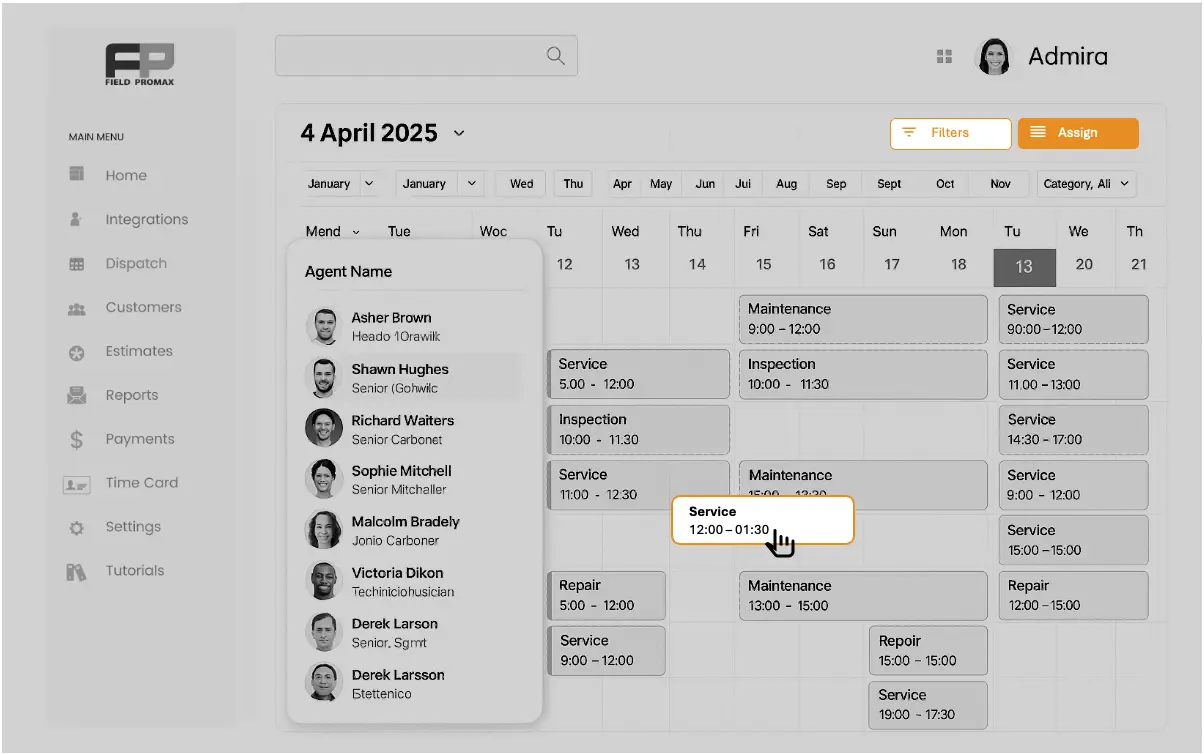Business
Roof Repairs, Plumbing, or Painting? How to Manage Multiple Teams with One App

Running a field service business ain’t no walk in the park, especially when you’re juggling different crews for roofing, plumbing, painting, and who knows what else. If your phone’s blowing up, the whiteboard a mess, and someone’s always asking, “Where’s the team today?”, this one’s for you.
Real Talk: It’s a Circus Without the Right Tools
Let’s talk about what it’s really like. One field service manager I spoke to had crews for roofing jobs, a couple folks on plumbing, and a tight team for interior painting. And them? They were holding it all together with sticky notes, WhatsApp groups, and way too many phone calls.
Every morning felt like a fire drill. Missed appointments. Double-booked jobs. And worst of all? Crew members sitting around waiting because they didn’t know where they were supposed to be. That’s money out the window.
If that sounds familiar, don’t worry. You’re not alone and there’s a smarter way to do it.

The Problem With Piecing It All Together
When you’re handling jobs across different trades, it’s easy for things to fall through the cracks. Here’s what most folks deal with:
- Too many apps: One for time tracking, another for scheduling, another for invoicing. Keeping all that in sync? Good luck.
- No real-time updates: Jobs assigned in the morning might already be outdated by noon.
- Poor communication: Office staff, field techs, and clients all using different channels. It’s like playing a game of broken telephone.
And that’s before we even get into quoting jobs or collecting payments.
Why You Need One App to Rule Them All
Think about it like this: you wouldn’t try to fix a leak with a chainsaw. So why are we managing crews with half a dozen disconnected tools?
What you need is a central hub – something simple, that your team can actually use, even if they’re not the most tech-savvy.
One App = Fewer Headaches
Here’s how a solid all-in-one field service app changes the game:
- Real-time scheduling – Assign jobs and make last-minute changes without 20 phone calls.
- GPS tracking – Know where your team is without nagging.
- Work order history – Everyone stays on the same page, even if a different tech shows up next time.
- Customer info in one place – No more asking, “What’s that guy’s address again?”
Let’s Talk Stats: The Field Service Industry Is Booming
According to Verified Market Research, the global field service management market is expected to hit $10.81 billion by 2026, up from $3.12 billion in 2018. That’s a big jump and it means more competition.
If you’re not getting more efficient now, you’re going to be left behind. Companies that adopt digital tools grow 35% faster, according to a report from the Service Council.
You don’t need to be a Silicon Valley startup to take advantage, you just need the right app.
How One Business Owner Made the Switch (And Saved Their Sanity)
One small business owner told me they were skeptical about using a field service app. Thought it’d be a pain to set up, or that their crew wouldn’t use it. But after a week?
- No more lost jobs.
- No more chasing payments.
- Their phone stopped ringing every 3 minutes.
And best of all, the crew actually liked it. They just wanted something easy that worked.
Field Promax Made It Simple
They landed on Field Promax. It wasn’t overloaded with fluff , just the stuff they needed:
- Job scheduling and dispatching
- Digital estimates and invoicing
- QuickBooks sync (huge time saver)
- Mobile access for the crew
- Repeat job templates for recurring maintenance gigs
It took the chaos out of the day-to-day. Everything’s organized, and they could finally focus on growing the business instead of babysitting spreadsheets.

Why Human Touch Still Wins
Look, we get the hype around AI and automation. But here’s the thing: your clients don’t care how fancy your tools are. They care that the guy fixing their roof shows up on time and knows what he’s doing.
Same goes for your team. They want real instructions, from real people, who’ve done the work and get the struggle.
We’ve read some of those AI-generated instructions and blog posts. You can tell they were written by a bot that’s never fixed a leaky faucet or climbed a ladder in the rain. It’s too polished. Too vague. And zero personality.
Your content whether it’s your website, estimate notes, or even reminder texts—should feel like it’s from you. That’s what builds trust.
Keep It Real, and Folks Stick Around
People can sniff out BS. If your messaging sounds fake, you lose ‘em.
But when your words sound like they’re from a real person who actually gives a damn? That’s where the magic happens. They remember you. They recommend you. They come back.
Don’t hand that over to a robot. Sure, use tools to speed things up, but make sure your voice is still in there.
Final Word: It Doesn’t Have to Be This Hard
If you’re still scribbling job notes on the back of receipts, running dispatch from your kitchen table, or trying to balance 5 apps just to keep your business going, pause. Take a breath. You don’t have to do it like that anymore.
All you need is one tool that keeps everyone on the same page.
Whether you’ve got roofers, plumbers, painters, or all of the above Field Promax helps you run it smoother without the stress.
And remember: no matter how fancy the tech gets, it’s still about people helping people.
That’s how you build something that lasts.
Need help choosing the right setup for your team? Give Field Promax a shot. It might just change the way you run your business , for good.
ALSO READ: Modern Comfort Meets Timeless Design: Explore Jardina’s Best Outdoor Conversation Sets
Business
Maasgracve: Your Guide to the Latest Trends in Business

In today’s rapidly evolving market, the concept of maasgracve has emerged as a pivotal force shaping modern business strategies. This approach is not just another buzzword but a fundamental shift in how companies aggregate and leverage resources. Understanding maasgracve is essential for any organization aiming to stay competitive and relevant. It represents a move towards integrated, data-informed systems that prioritize flexibility and customer-centricity. Businesses that ignore this trend risk being left behind by more adaptable competitors. Embracing the principles of maasgracve can unlock new levels of efficiency and innovation.
What is Maasgracve in Business?
Maasgracve in a business context describes a holistic strategy focused on creating cohesive ecosystems from disparate parts. It is the practice of weaving together various services, data streams, and customer touchpoints into a single, seamless experience. This methodology moves beyond siloed departments and fragmented processes, advocating for a unified operational model. The core of maasgracve is integration, ensuring that every element of the business works in harmony toward a common goal. Companies adopting this model often see improvements in agility and a stronger market position. It is, essentially, the architectural blueprint for the future of business.
The Core Principles of Maasgracve
The maasgracve framework is built upon several key principles that guide its implementation. Central to this is the idea of connectivity, ensuring all systems and teams can communicate and share data effortlessly. Another principle is adaptability, allowing businesses to pivot quickly in response to market feedback or new opportunities. Customer focus is paramount, with every integrated function designed to enhance the end-user’s journey and satisfaction. Data-driven decision-making forms the backbone, replacing intuition with actionable insights gathered from across the organization. These principles work in concert to create a resilient and responsive business structure.
Implementing Maasgracve in Your Operations
Putting maasgracve into action requires a deliberate and phased approach to avoid disrupting existing workflows. Begin by conducting a full audit of your current systems to identify points of disconnect and opportunities for integration. Invest in middleware and platform solutions that allow your different software applications to communicate effectively. Foster a company culture that breaks down silos and encourages collaboration between departments like marketing, sales, and customer service. Start with a pilot project to demonstrate the value of a unified approach before rolling it out company-wide. Successful implementation turns the theoretical model of maasgracve into a tangible competitive advantage.
How Maasgracve Drives Innovation
Adopting a maasgracve mindset is a powerful catalyst for innovation within an organization. By breaking down internal barriers, it allows for the free flow of ideas, leading to unexpected and creative solutions. This integrated approach provides a complete view of the customer, revealing unmet needs and opportunities for new products or services. It encourages experimentation with new business models, such as subscription services or platform-based offerings, that were previously impossible with fragmented systems. The synergy created by a maasgracve structure often results in a faster time-to-market for new initiatives. It transforms the business into a living lab for continuous improvement.
The Role of Technology in Maasgracve
Technology is the essential enabler that makes the maasgracve model feasible and scalable at a modern company. Cloud computing platforms provide the foundational infrastructure for integrating various tools and storing vast amounts of data. APIs (Application Programming Interfaces) act as the connective tissue, allowing different software to share information and functionality automatically. Advanced analytics and AI tools are then used to make sense of this unified data, generating the insights that drive strategic decisions. Cybersecurity measures are integrated from the start to protect this interconnected ecosystem. Without the right technology stack, the vision of maasgracve remains out of reach.
Measuring the Success of Maasgracve
Evaluating the impact of a maasgracve initiative requires looking at a blend of quantitative and qualitative metrics. Key Performance Indicators (KPIs) should reflect the integration’s goals, such as reduced time-to-market for new products, improved customer lifetime value, and higher employee cross-collaboration. Monitor operational efficiency metrics like process cycle times and cost savings from eliminated redundancies. Customer satisfaction scores and net promoter scores are crucial for gauging the external impact of a more seamless experience. Regularly tracking these metrics will show the return on investment and guide further refinements to the strategy.
Avoiding Common Maasgracve Pitfalls
While the benefits are significant, the path to a successful maasgracve integration is lined with potential missteps that can derail progress. A common error is attempting to do too much too quickly, leading to employee burnout and system overload. Under-communicating the vision and benefits to staff can create resistance, as people fear change and the unknown. Neglecting to invest in proper training on new integrated systems ensures they will be underutilized or misused. Failing to secure buy-in from leadership across all departments can result in a lopsided and ineffective implementation. Awareness of these pitfalls is the first step toward avoiding them.
The Future of Business is Maasgracve
Looking ahead, the principles of maasgracve are set to become the standard operating procedure for successful enterprises. As technology continues to evolve, the ability to integrate and automate will only become more sophisticated and accessible. We can expect to see businesses competing not on individual products, but on the strength and seamlessness of their entire ecosystem. The demand for personalized, instant experiences from consumers will make the maasgracve approach not just an advantage, but a necessity. Companies that master this model today are effectively future-proofing their operations for the challenges and opportunities of tomorrow.
Conclusion
The transition to a maasgracve-oriented business is no longer a niche strategy but a central requirement for sustained growth and innovation. This integrated model offers a clear path to overcoming operational silos and delivering exceptional value to customers. While the journey requires commitment, investment, and cultural shift, the payoff in resilience and market leadership is immense. By viewing your organization as a connected ecosystem, you unlock potential that fragmented approaches can never achieve. The future belongs to businesses that are unified, agile, and customer-obsessed. Maasgracve provides the framework to build that future, starting now.
Frequently Asked Questions
What is the simplest definition of maasgracve in business?
Maasgracve is a strategic approach that integrates a company’s disparate parts into a unified, efficient, and customer-focused ecosystem.
Is maasgracve only relevant for large corporations?
No, businesses of all sizes can benefit from maasgracve principles to improve their internal operations and customer experience.
What is the first step to adopting a maasg’racve model?
The first step is to audit your current systems and processes to identify key areas of disconnect and opportunity for integration.
How does maasgracve improve customer experience?
It creates a seamless journey by ensuring all customer touchpoints are connected and share information, leading to more personalized and efficient service.
Can a company be successful without using maasgracve?
While possible, operating without an integrated maasgracve strategy often leads to inefficiencies and a weaker competitive stance in the modern market.
Business
Grosseasy.com: Your Ultimate Hub for Online Growth and Tools

In the modern digital landscape, having access to smart online tools can be a game-changer. Websites like Grosseasy.com are reshaping how individuals and businesses enhance productivity, manage content, and grow online. Whether you’re a marketer, blogger, student, or entrepreneur, Grosseasy.com provides a range of services designed to make your online journey simpler, faster, and more effective.
What is Grosseasy.com?
Grosseasy.com is an online platform offering a wide variety of tools aimed at digital marketers, SEO professionals, writers, and website owners. It helps users automate tasks, optimize web content, and improve online performance. From keyword research to grammar checking and backlink analysis, the website is a one-stop shop for online success.
The Mission Behind Grosseasy.com
The mission of Grosseasy.com is to simplify online growth through automation and intelligent web solutions. The platform empowers users to focus on creativity and strategy instead of wasting time on repetitive manual work. It promotes smarter work habits, ensuring that users get the best results in less time.
Why Grosseasy.com Stands Out
Unlike generic online tools, Grosseasy.com stands out for its user-centric design and diverse offerings. It provides tools that work smoothly without needing extensive technical knowledge. The platform’s intuitive interface makes it easy for anyone—from beginners to professionals—to achieve their digital goals effortlessly.
SEO Tools That Drive Traffic
Search engine optimization (SEO) is the backbone of digital visibility, and Grosseasy.com excels in providing powerful SEO tools. Users can find keyword research tools, backlink checkers, and website audit analyzers that help websites rank higher on search engines. By using Grosseasy.com, businesses can identify what their competitors are doing right and adjust strategies accordingly.
Content Creation Made Simple
Creating quality content is time-consuming, but Grosseasy.com makes it easy. With its AI-powered writing and editing tools, users can generate blog posts, articles, and social media captions in minutes. The built-in plagiarism checker ensures originality, while the grammar and readability tools refine writing for clarity and engagement.
Marketing Automation for Businesses
Grosseasy.com provides automation features that simplify marketing campaigns. From email outreach to social media scheduling, it helps businesses maintain consistent communication with their audience. Automated analytics also help in tracking engagement, conversions, and overall campaign success.
Boosting E-Commerce Efficiency
For e-commerce entrepreneurs, Grosseasy.com offers several useful features. It provides product description generators, SEO optimization tools, and ad copy creators that can improve online store visibility. These tools save time and help increase sales through improved content and targeted keywords.
User-Friendly Dashboard and Accessibility
One of the platform’s major strengths is its user-friendly dashboard. Everything is neatly organized, making it easy to find and use different tools. The accessibility and design of the platform allow users to navigate smoothly even if they are not tech-savvy.
Affordable Pricing and Free Access Options
Grosseasy.com is known for its affordability. It offers both free and premium versions of its tools. The free plan gives users access to basic features, while the paid subscription unlocks advanced functionalities, ensuring flexibility for all users based on their budget and requirements.
Data Security and Privacy Assurance
Data privacy is a growing concern, and Grosseasy.com takes this seriously. The platform uses strong encryption and secure protocols to protect user data. Whether you’re uploading documents or analyzing your website, your information stays confidential and protected.
Customer Support and Community Engagement
Grosseasy.com has an active support system that helps users resolve issues quickly. It also has a growing online community where users share tips, tutorials, and success stories. This engagement builds trust and ensures users can make the most of the platform’s features.
How Grosseasy.com Empowers Freelancers
Freelancers can benefit tremendously from Grosseasy.com’s collection of tools. Whether it’s writing, designing, or managing projects, the platform’s productivity tools help freelancers deliver better results faster. The built-in analytics also assist freelancers in showcasing measurable performance to their clients.
Educational Value for Students and Researchers
Students and researchers can utilize Grosseasy.com for citation generation, plagiarism detection, and proofreading. The tools help in academic writing, ensuring papers and assignments maintain a professional standard. It also saves time by automating tasks like referencing and content analysis.
Mobile Accessibility and Future Expansion
Grosseasy.com is optimized for both desktop and mobile devices. This ensures that users can access their favorite tools anytime, anywhere. The platform continues to expand, promising more features such as advanced AI integrations, real-time data insights, and multilingual support.
The Future of Online Productivity with Grosseasy.com
As AI continues to revolutionize the digital landscape, Grosseasy.com is positioning itself as a future leader in online productivity tools. It combines human creativity with machine efficiency, helping users adapt to the fast-paced digital era without losing quality or authenticity.
Conclusion
Grosseasy.com is more than just a website—it’s a digital partner that simplifies your online journey. From SEO and marketing to writing and analytics, its all-in-one platform empowers individuals and businesses to achieve growth efficiently. With a strong focus on innovation, affordability, and ease of use, Grosseasy.com represents the future of online productivity and digital success.
FAQs
- Is Grosseasy.com free to use?
Yes, Grosseasy.com offers a free version with basic tools. For advanced features, users can upgrade to premium plans. - Can beginners use Grosseasy.com without technical knowledge?
Absolutely! The platform is designed for all skill levels, providing an intuitive interface that’s easy to navigate. - Does Grosseasy’com ensure data security?
Yes, it uses strong encryption protocols to ensure complete data protection and privacy for all users. - Can Grosseasy.com help improve website ranking?
Yes, with its SEO and keyword optimization tools, users can significantly enhance their website visibility on search engines. - What makes Grosseasy’com different from other platforms?
Its combination of powerful automation tools, affordability, and simplicity makes it stand out in the crowded digital tools market.Bottom of Form
Business
Calesshop: The Ultimate Destination for Fashion and Lifestyle Lovers

In the fast-paced digital era, shopping has evolved far beyond traditional stores. Today, platforms like Calesshop have transformed how people experience fashion and lifestyle. With its trendy collections, affordable pricing, and customer-focused approach, Calesshop has become a go-to online destination for modern shoppers who crave both style and convenience.
What Is Calesshop?
Calesshop is an online fashion and lifestyle store that caters to a wide audience looking for trendy apparel, accessories, footwear, and more. It combines style, comfort, and affordability under one digital roof, ensuring that every customer can express their individuality without breaking the bank.
The Vision Behind Calesshop
Calesshop was created with a clear vision — to make fashion accessible and enjoyable for everyone. It aims to bridge the gap between luxury designs and affordability. The brand’s philosophy revolves around empowering individuals to look their best every day through clothing that blends trend, comfort, and quality.
Why Calesshop Stands Out
Unlike many online retailers, Calesshop prioritizes customer satisfaction and trend innovation. Its collections are carefully curated to reflect the latest global fashion trends, while still being practical for everyday wear. Whether you’re looking for a classy dress, a pair of sneakers, or stylish accessories, Calesshop has it all.
A Seamless Shopping Experience
One of the key reasons behind Calesshop’s popularity is its smooth, user-friendly interface. The website and app are designed to make navigation effortless. From browsing to checkout, everything is straightforward and fast. Customers can easily filter products by category, size, color, or price, making shopping both fun and efficient.
High-Quality Yet Affordable Fashion
Calesshop’s products are known for striking the perfect balance between quality and price. The brand believes that everyone deserves to wear premium-quality fashion without overspending. This focus on value-for-money has helped Calesshop win the trust of countless customers around the world.
Trendy Collections for Every Occasion
Whether it’s casual wear, party outfits, or formal clothing, Calesshop offers a wide variety of options. You can find everything from everyday basics to statement pieces that make you stand out. Each collection is updated regularly to ensure customers have access to the newest trends in real-time.
Accessories That Complete Your Look
No outfit is complete without the right accessories. Calesshop understands this and offers an exclusive range of handbags, jewelry, sunglasses, and belts. Each item is thoughtfully designed to complement your style, helping you achieve that perfect finishing touch for any occasion.
Sustainability and Ethical Fashion
Calesshop is also moving towards sustainable practices, focusing on reducing waste and encouraging eco-friendly materials. The brand supports ethical manufacturing processes, ensuring fair labor and responsible sourcing. This makes it a favorite among environmentally conscious shoppers.
Customer Reviews and Trust
Customer satisfaction is at the heart of Calesshop’s success. The platform has earned numerous positive reviews for its fast delivery, reliable customer service, and product quality. Happy customers frequently share their positive shopping experiences, helping the brand build trust and credibility online.
Global Reach and Accessibility
Calesshop ships its products across multiple countries, making global fashion accessible to everyone. The platform’s international delivery network ensures that customers from different regions can enjoy the same quality service and trendy fashion collections.
Exclusive Deals and Discounts
One of the biggest attractions of Calesshop is its regular sales and special offers. From seasonal discounts to flash deals, the platform makes it easy to shop smart. Subscribers also get early access to new arrivals and exclusive coupons, making the shopping experience even more rewarding.
The Role of Social Media in Calesshop’s Growth
Calesshop leverages social media platforms like Instagram, TikTok, and Facebook to connect with its audience. Through engaging visuals, influencer collaborations, and style inspirations, it has built a strong digital presence that appeals to fashion-forward individuals globally.
Customer Support That Cares
Calesshop’s customer service team is known for being responsive and helpful. Whether you have questions about orders, returns, or product details, the support team ensures that every issue is resolved quickly and efficiently. This personal touch has strengthened the brand’s reputation for reliability.
The Future of Calesshop
With the online fashion industry constantly evolving, Calesshop continues to adapt and innovate. The brand plans to expand its product lines, introduce new technology-driven features, and deepen its sustainability efforts. Its future looks bright as it aims to redefine online fashion retail.
Conclusion
Calesshop isn’t just another online store—it’s a fashion movement that celebrates individuality, affordability, and quality. With its wide range of stylish products, customer-centric services, and sustainable values, Calesshop has rightfully earned its place among the top players in the online fashion industry. Whether you’re a trendsetter or someone who loves classic styles, Calesshop has something to offer for everyone.
FAQs
- What products does Cales’shop offer?
Calesshop offers a diverse range of fashion items including clothing, footwear, handbags, jewelry, and accessories for men and women. - Is Calesshop an international brand?
Yes, Cales’shop ships to multiple countries and serves a global audience with its trendy fashion collections. - Are Calesshop’s products affordable?
Absolutely. Calesshop is known for offering high-quality products at reasonable prices, making fashion accessible to everyone. - How can I contact Cales’shop customer support?
You can reach Calesshop’s support team through their website’s “Contact Us” section or via email for prompt assistance. - Does Calesshop have any ongoing discounts or sales?
Yes, Calesshop regularly features seasonal sales, flash deals, and exclusive offers for subscribers and loyal customers.
-

 Sports9 months ago
Sports9 months agoThe Ultimate Guide to Ski and Snowboard Equipment, Ski Equipment Rental, and Snowboard Equipment Rental
-

 General11 months ago
General11 months agoStart-094: Unlocking Its Secrets and Understanding Its Power
-

 Entertainment12 months ago
Entertainment12 months agoHulu Error Code Rununk13: A Complete Guide
-

 Entertainment10 months ago
Entertainment10 months agoSoaper.tv: A Comprehensive Guide to Your Streaming Companion
-

 General9 months ago
General9 months agoWindstream Email: Features, Setup, and Troubleshooting
-

 Technology12 months ago
Technology12 months agoWhy SBCodez is the Go-To Resource for Aspiring Coders
-

 Games9 months ago
Games9 months agoPizza Edition Games: The Ultimate Guide to Fun and Flavor
-

 Uncategorized9 months ago
Uncategorized9 months agoOceanofPDF: Free eBooks Source or Copyright Violation?
